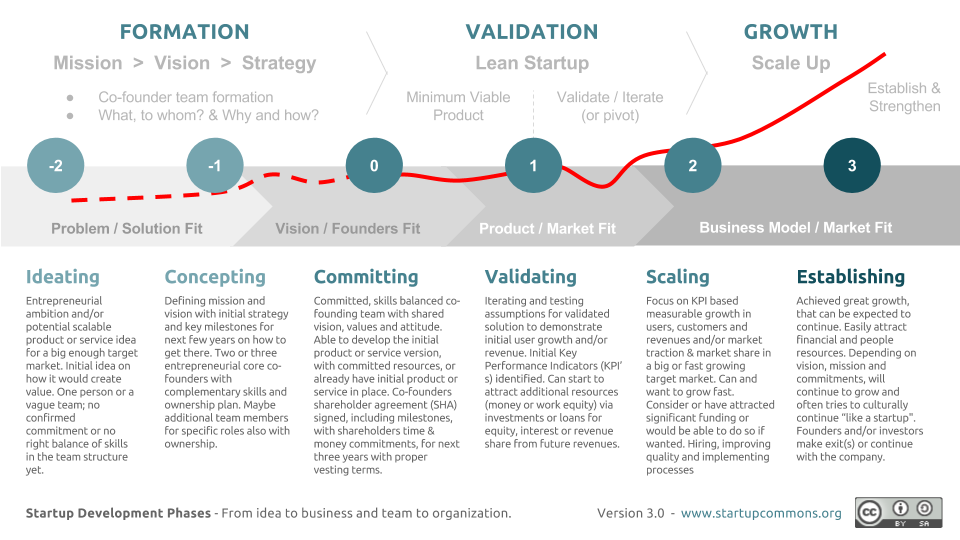Nearly half (42%) of startups fail due to a lack of product-market fit. Often, these failures occur when founders mistakenly believe they've found product-market fit and start hiring people and increasing burn, limiting their runway to pivot before running out of capital.
Let's take a closer look at product-market fit, how to measure it, and strategies to help your startup succeed.
What is Product-Market Fit?
Product-market fit is the degree to which a product satisfies strong market demand.

How product-market fit looks within the venture capital timeline. Source: StartupCommons
A lack of a product-market fit becomes apparent when customers aren't getting enough value out of the product, you're not getting a lot of word-of-mouth referrals, and you have a long sales cycle.
In other words: you may have come across a problem that customers want to solve, but the solution may be inadequate, or the pain point you've identified isn't significant enough.
How to Reach Product-Market Fit
The first, and probably most important step in the process should always be validating that there's a problem-solution fit before you jump into development.
This might seem like an obvious enough tip. Still, unfortunately, the reality is that many founders make the mistake of prioritizing their solution over the actual market needs and the problems of their potential customers.
Michael Seibel notes that founders should seek out customers who "have their hair on fire." To put it bluntly, the customers should have a problem so great that they prioritize solving it above everything else. More importantly, they should be willing to try out imperfect solutions to solve that problem an ideal growth foundation for startups.
Once you've identified a problem-solution fit, the next step is building a minimum viable product (MVP). Marc Andreessen famously said, "the market pulls product out of the startup."
The MVP is almost never an ideal solution to the problem, but it is a ready-to-use product that, with feedback from early adopters, will help you to find a perfect answer to your clients' problems
Measuring Product-Market Fit
Once you have an MVP, you can measure the product-market fit by looking at quantitative metrics.
Ideally, you're charging customers for early access, enabling you to accurately measure real interest and conversion rates. That said, even if you only collect email addresses, you can still roughly estimate how a potential solution resonates with would-be customers.
Some early-stage metrics to track on your website include:
Bounce Rate - How many visitors look at more than one page on your site (e.g., they're interested in learning more)?
Time on Site - How long do visitors spend on the landing page?
Pages per Visit - How many pages does each visitor look at?
Returning Visitors - What percentage of your visitors come back?
These are early signs of product-market fit—or at least problem-solution fit.
While a high percentage of returning visitors is a positive sign, it doesn't mean that paying customers will stick around after subscribing to your service. As the MVP matures, startups should start looking at more detailed metrics to better understand product-market fit.
Iterating & Improving Product-Market Fit
Product-market fit doesn't end when your MVP gains traction among a small subset of customers.
Until you start struggling to keep up with demand, you still need to measure metrics like the net promoter score (NPS) and other engagement statistics in older to learn, improve and iterate.
Some core metrics to watch include:
Churn Rate - How many customers are sticking around after a free trial or the first months of their subscription?
NPS / Referrals - How many customers are willing to recommend your product—and how many actually make recommendations?
Customer Lifetime Value - What is the average profit that you make from a customer’s entire lifetime?
Conversion Rate - How many leads are converting into customers and how long is your sales cycle?
As mentioned earlier, if you're struggling to keep up with demand, then it means you have product-market fit figured out. Additionally, look for high conversion rates, rising customer lifetime values, a high percentage of referrals, and low churn rates.
Some experts recommend measuring product-market fit with the 40% rule. It means that at least 40% of customers should be "very disappointed" if they no longer have access to your product or service. In other words, you've developed a highly-effective solution that addresses a very painful problem, and customers would be in trouble without it.
The Bottom Line
Startups should focus almost all of their resources on achieving a product-market fit before investing in anything else. At the same time, they should keep their burn rate at a minimum until that point to maximize their odds of success. As Michael Siebel says, "stay lean, keep burn low, and resemble a Navy SEAL team instead of an Army battalion."
If you're looking for a team to handle your hardware or connected device project, Intent is here to help you: our experts will take care of design sprints, user interviews, and other processes to validate early-stage ideas and transform them into effective MVPs. Don't hesitate to contact us!

Greg Cargopoulos
Marketing Lead

